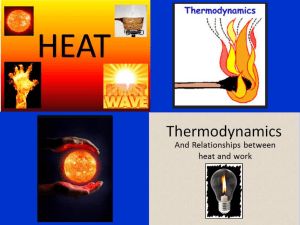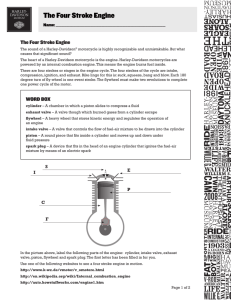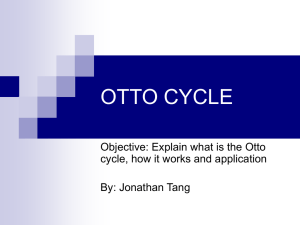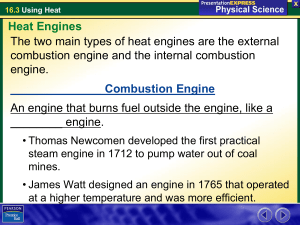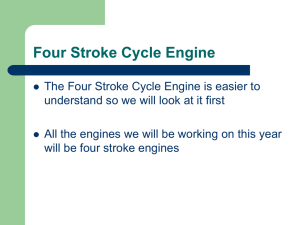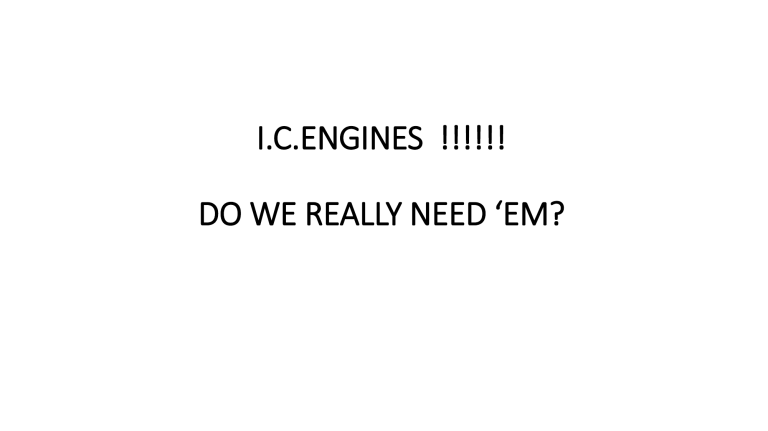
I.C.ENGINES !!!!!! DO WE REALLY NEED ‘EM? I have always considered that the substitution of the Internal Combustion Engine for the horse marked a very gloomy milestone in the progress of mankind. -Winston Churchill ENGINES BOON OR BANE ? • Greatest invention since the wheel? • Made transportation easy! • Made life easy! OR DID IT? • Increased pollution • Increased fossil fuel consumption • Increased congestion on roads BUT……….. • WHETHER WE LIKE IT OR NOT…. CAN WE DO WITHOUT IT? • DO WE HAVE VIABLE ALTERNATIVES? THINK……… • AS OF TODAY WE HAVE NO ANSWER • MAY BE FOR AT LEAST 20 YEARS MORE! • SO WE ARE STUCK WITH IT………! SO WE STUDY IT………….! And so on to the course: Engine An engine is motor which converts chemical energy into mechanical energy History • Otto Cycle: Dr. Nicolaus Otto -1876 • 2-Cycle Engine; Du gal Clerk -1878 History • Diesel Engine; Dr. Rudolph Diesel -1895 CLASSIFICATION OF INTERNAL COMBUSTION ENGINES VARIOUS TYPES OF ENGINES Engines can also be classified according to whether the fuel is burnt inside or outside the engine INTERNAL COMBUSTION ENGINES EXTERNALENGINES (Steam Engine) CLASSIFICATION OF ENGINES Engines can be classified according to the fuel they use PETROL ENGINES DIESEL ENGINES The engines may be classified according to 1.Number of cylinders 2.Cylinder arrangements 3.Valve arrangements 4.Speed of the engines 5.Cooling system 6.Lubrication system used 7.Number of strokes used. Vertical Engines HORIZONTAL ENGINE ROTARY ENGINE RADIAL ENGINE V TYPE STIRLING ENGINES Terminology Stroke is the distance of the piston travels from BDC to TDC stroke TDC BDC FOUR STROKE ENGINES FIRST STROKE –SUCTION STROKE While the inlet valve is open ,the descending piston draws fresh petrol and air mixture into the cylinder. Fig. FOUR STROKE ENGINES FIRST STROKE –SUCTION STROKE While the inlet valve is open ,the descending piston draws fresh petrol and air mixture into the cylinder. IN LET VALVE OPEN POSITION EXHAUST VALVE CLOSE POSITION Fig. FOUR STROKE ENGINES FIRST STROKE –SUCTION STROKE While the inlet valve is open ,the descending piston draws fresh petrol and air mixture into the cylinder. IN LET VALVE OPEN POSITION EXHAUST VALVE CLOSE POSITION Fig. FOUR STROKE ENGINES FIRST STROKE –SUCTION STROKE While the inlet valve is open ,the descending piston draws fresh petrol and air mixture into the cylinder. IN LET VALVE OPEN POSITION EXHAUST VALVE CLOSE POSITION Fig. FOUR STROKE ENGINES FIRST STROKE –SUCTION STROKE While the inlet valve is open ,the descending piston draws fresh petrol and air mixture into the cylinder. IN LET VALVE OPEN POSITION EXHAUST VALVE CLOSE POSITION Fig. SECOND STROKE-COMPRESSION STROKE While the valves are closed,the rising piston compresses the mixture to a pressure about 7-8atm; the mixture is then ignited by the spark plug. IN LET VALVE CLOSE POSITION EXHAUST VALVE CLOSE POSITION Fig. SECOND STROKE-COMPRESSION STROKE While the valves are closed,the rising piston compresses the mixture to a pressure about 7-8atm; the mixture is then ignited by the spark plug. IN LET VALVE CLOSE POSITION EXHAUST VALVE CLOSE POSITION Fig. SECOND STROKE-COMPRESSION STROKE While the valves are closed,the rising piston compresses the mixture to a pressure about 7-8atm; the mixture is then ignited by the spark plug. IN LET VALVE CLOSE POSITION EXHAUST VALVE CLOSE POSITION Fig. SECOND STROKE-COMPRESSION STROKE While the valves are closed,the rising piston compresses the mixture to a pressure about 7-8atm; the mixture is then ignited by the spark plug. IN LET VALVE CLOSE POSITION EXHAUST VALVE CLOSE POSITION Fig. THIRD STROKE-POWER STROKE While the valves are closed the pressure of the burned gases of the combustion forces push the piston downwards. IN LET VALVE CLOSE POSITION EXHAUST VALVE OPEN POSITION Fig. FOURTH STROKE-EXHAUST STROKE The exhaust valve is open and the rising piston discharges the spent gases from the cylinder. Fig. SUCTION STROKE COMPRESSION STROKE POWER STROKE EXHAUST STROKE Petrol Engine Vs Diesel Engine _ Difference _ Comparision.mp4 Petrol (Gasoline) Engine vs Diesel Engine [720p].mp4 ADVANTAGES OF FOUR STROKE ENGINES 1.Less fuel consumption 2.Thermal efficiency is more 3.More volumetric efficiency 4.Less wear and tear. DISADVANTAGES OF FOUR STROKE ENGINES 1.More components 2.Separate valve operating mechanism is required. 3.More cost 4.More complicated design. Two-Stroke Engine Upward Stroke • Piston moving upward • Crankcase pressure drops • Intake port exposed • Intake air enters through carburetor pulls fuel and oil into crankcase Downward Stroke • • • • Piston moving downward Exhaust port exposed Exhaust gases expelled Complete exhausting occurs when transfer ports are opened • New charge rushes in Working of 2 – Stroke engine How 2 Stroke Engine Works.mp4 4 – Stroke Vs 2 - Stroke 2 Stroke Engine Vs 4 Stroke Engine _ Difference _ Comparison _ Opinion.mp4 Lets take a quiz to see what you have learned! Back Quiz 1. The ____ controls the amount of intake and the release of exhaust. a. head b. valves c. coolant d. connecting rod 2. The _____ stroke is the ignition of the compressed fuel-air mixture. a. Exhaust b. Combustion c. Compression d. Intake 3. The most common type of engine? a. diesel engines b. 2-stroke engines c. rotary engines d. 4-stroke engines 4. What part of the engine converts up and down motion into a rotation motion? a. crankshaft b. piston c. valve cover d. camshaft 5. What is the name of the part listed? a. intake valve b. piston c. oil pan d. spark plug Most high speed compression engines operates on...... A. Diesel cycle B. Otto cycle C. Dual combustion cycle C. Carnot cycle Which of the following is not an internal combustion engine....... A.2 stroke petrol engine B.4 stroke petrol engine C.Diesel engine D.Steam turbine The thermal efficiency of two stroke cycle engine is.....a four stroke cycle engine A.Equal to B.Less than C.Greater than D.None of the above A two stroke cycle engine gives......the number of power strokes as compared to the four stroke cycle engine,at the same engine speed A.Half B.Same C.Double D.Four times In a four stroke engine, the working cycle is completed in....... A.One revolution of the crankshaft B.Two revolution of the crankshaft C.Three revolution of the crankshaft D.Four revolution of the crankshaft The thermodynamic cycle in which petrol engine works, is...... A.Otto cycle B.Diesel cycle C.Rankine cycle D.Stirling cycle Which of the following does not relate with spark ignition engine...... A.Ignition coil B.Spark plug C.Distributor D.Fuel injector The power developed by the engine cylinder of an I.C. engine is known as....... A.Indicated power B.Break power C.Actual power D.None of the above Valve Operation Camshaft and Valves [720p].mp4 Valve timing diagram The valve timing diagram is a graphical representation of opening and closing of inlet valve and exhaust valve IC Engine Valve and Port Timing Diagram.mp4 Port timing diagram Port Timing diagram illustrates how the events such as the Inlet port, Exhaust port and Transfer ports are open and closes Air Standard Cycles P Otto Cycle 1 3 2 3 4 2 TDC 4 BDC 1 BDC TDC • 1-2 Isentropic compression from BDC to TDC W12 m u2 u1 v T 3 • 2-3 Isochoric heat input (combustion) Q23 m u3 u2 • 3-4 Isentropic expansion (power stroke) W34 m u3 u4 4 2 • 4-1 Isochoric heat rejection (exhaust) Q41 m u4 u1 1 s 65 Thermodynamic Otto Cycle Air-standard analysis is a simplification of the real cycle that includes the following assumptions: 1) Working fluid consists of fixed amount of air (ideal gas) 2) Combustion process represented by heat transfer into and out of the cylinder from an external source 3) Differences between intake and exhaust processes not considered (i.e. no pumping work) 4) Engine friction and heat losses not considered Fuel-Air Models for Engine Cycles More accurate models are used for properties of each constituents. Process SI Engine CI Engine Intake Air+Fuel +Residual gas Air+ Recycles gas + Residual gas Compression Air+Fuel vapour +Residual gas Air+ Recycles gas + Residual gas Expansion Combustion products Combustion Products Exhaust Combustion products Combustion Products SI Engine Cycle vs Air Standard Otto Cycle FUEL A Ignition I R Fuel/Air Mixture Combustion Products Actual Cycle Intake Stroke Compression Stroke Power Stroke Qin Otto Cycle Air Exhaust Stroke Qout TC BC Compression Process Const volume heat addition Process Expansion Process Const volume heat rejection Process Actual SI Engine cycle Total Time Available: 10 msec Ignition Air Standard Vs Actual Otto Cycle Comparison between air standard and actual cycle The actual cycles for internal combustion engines differ from air-standard cycles in many respects. These differences are mainly due to: (i) The working substance being a mixture of air and fuel vapour or finely atomized liquid fuel in air combined with the products of combustion left from the previous cycle. (ii) The change in chemical composition of the working substance. (iii) The variation of specific heats with temperature. (iv) The change in the composition, temperature and actual amount of fresh charge because of the residual gases. (v) The progressive combustion rather than the instantaneous combustion. (vi) The best transfer to and from the working medium. (vii) The substantial exhaust blowdown loss, i.e., loss of work on the expansion stroke due to early opening of the exhaust valve. (viii) Gas leakage, fluid friction etc., in actual engines. • Out of all the above factors, major influence is exercised by, (i) Time loss factor i.e, loss due to time required for mixing of fuel and air and also for combustion. video combustion in cylinder - YouTube.flv • (ii) Heat loss factor i.e, loss of heat from gases to cylinder walls. • (iii) Exhaust blowdown factor I.e. loss of work on the expansion stroke due to early opening of the exhaust valve Time loss factor Heat loss How Car Cooling System Works.mp4 Exhaust blowdown Loss due to rubbing friction lubrication system.FLV Summary
